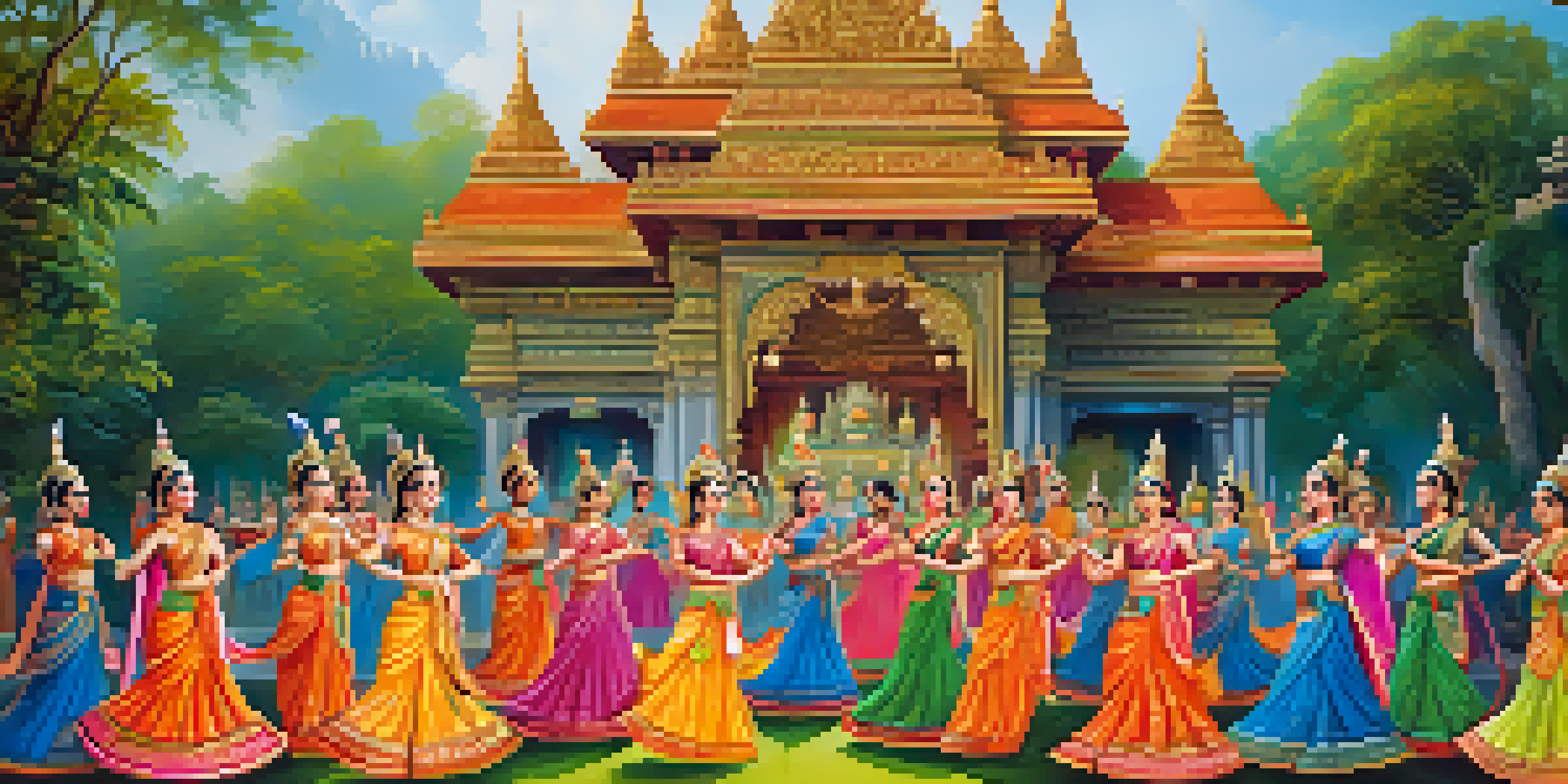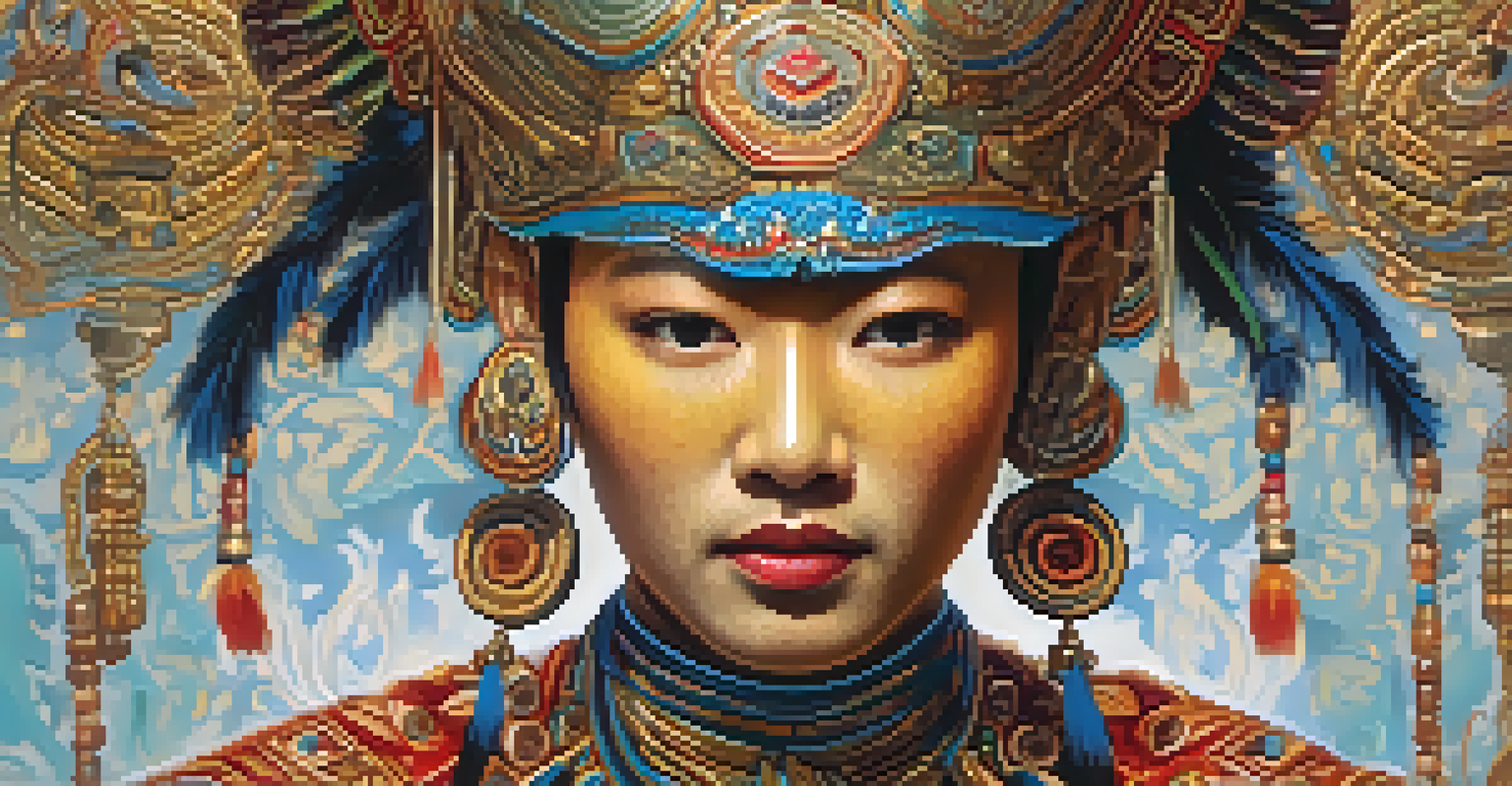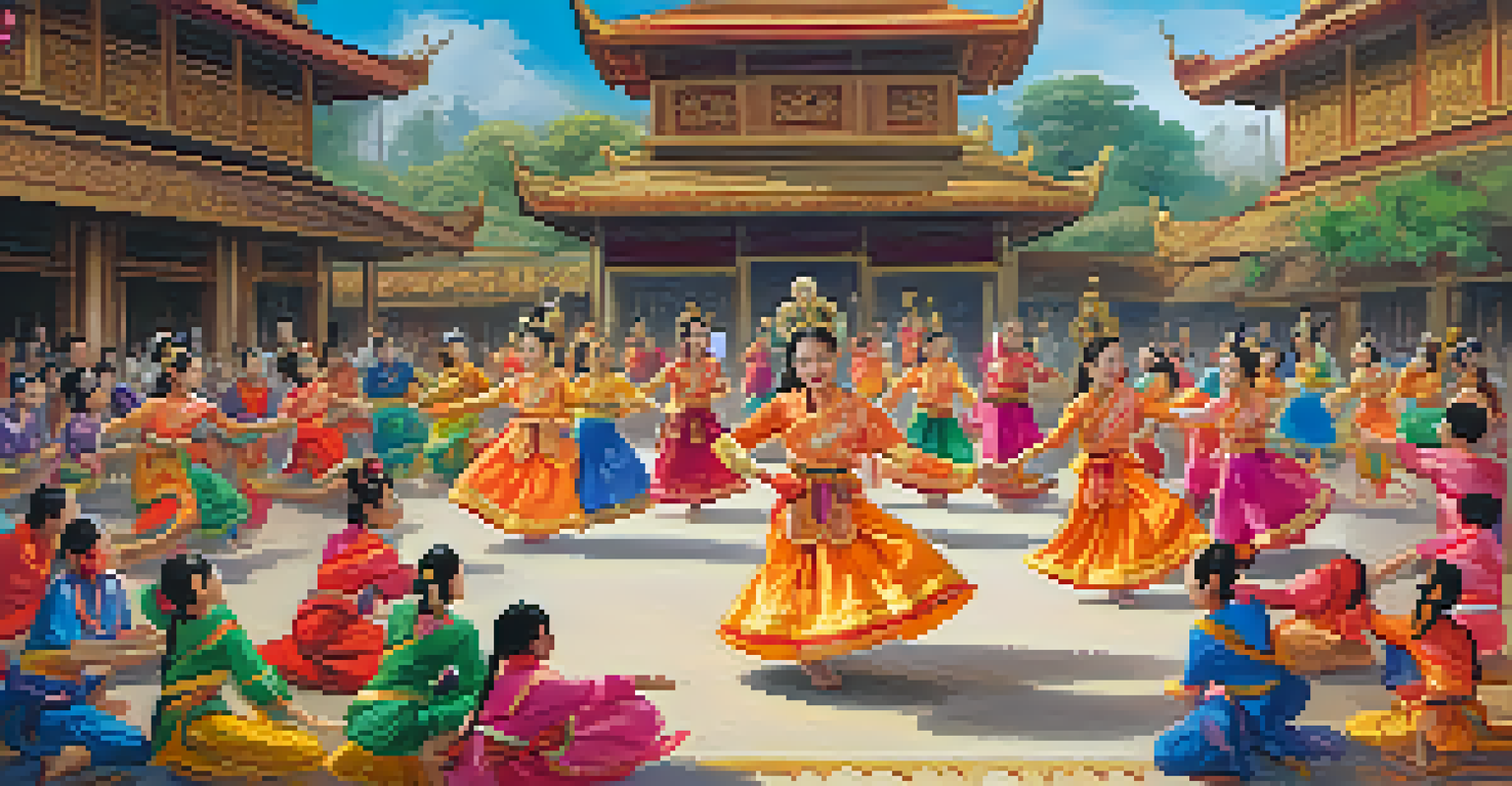Famous Traditional Thai Dance Styles and Their Meanings

Understanding the Essence of Thai Dance
Thai dance is a captivating form of storytelling that combines movement, music, and elaborate costumes. Each performance reflects the country's rich cultural heritage and religious beliefs. Through intricate gestures and expressions, dancers convey emotions and narratives that resonate deeply with the audience.
Dance is the hidden language of the soul.
This art form is not just for entertainment; it serves a purpose in ceremonies, rituals, and celebrations. For instance, many dances are performed during religious festivals, emphasizing the spiritual connection between the performers and their beliefs. By understanding Thai dance, one can appreciate the cultural values embedded within each performance.
Moreover, Thai dance often incorporates elements of theater, drawing spectators into a vivid world of mythology and history. This blend of artistry and storytelling makes it a unique treasure that showcases Thailand’s vibrant past and traditions.
Khon: The Royal Dance Drama
Khon is a highly stylized dance that narrates stories from the Ramakien, Thailand's national epic. Distinguished by its intricate movements and elaborate masks, this performance is often reserved for royal occasions, reflecting its majestic aura. The dancers, who typically perform in pairs, embody characters from the epic, bringing the story to life through graceful gestures.

The masks used in Khon are not only visually striking but also carry symbolic meanings. Each mask represents a character's traits and qualities, allowing the audience to connect with the story on a deeper level. The performers' movements, synchronized with traditional music, create an enchanting atmosphere that captivates viewers.
Thai Dance as Cultural Storytelling
Thai dance uniquely combines movement, music, and narrative, reflecting the country's rich heritage and spiritual values.
Today, Khon is celebrated as a UNESCO Intangible Cultural Heritage, ensuring its preservation for future generations. Attending a Khon performance is like stepping into a time machine, where spectators can witness the elegance and grandeur of ancient Thai culture.
Lakhon: The Versatile Thai Theatre
Lakhon is another traditional dance form that combines acting and dancing, often performed with a narrative structure. Unlike Khon, Lakhon typically focuses on everyday life stories, making it relatable to a broader audience. Its performances feature a mix of dialogue, song, and expressive movements, which create a lively and engaging atmosphere.
The essence of dance is not to impress but to express.
What sets Lakhon apart is its versatility; it can be performed by both men and women, allowing for diverse storytelling. The costumes are vibrant and reflect the characters' roles, adding a visual flair that enhances the overall experience. This dance style often incorporates humor and drama, appealing to various emotions.
Lakhon's ability to adapt and evolve over time has solidified its place in modern Thai culture. As new stories emerge, Lakhon continues to thrive, bridging the gap between tradition and contemporary expression.
Ramayana: Dance of the Gods
The Ramayana dance is a visual feast that depicts the adventures of Lord Rama and his quest to rescue Sita. This dance is characterized by its vibrant costumes and stylized movements that embody the essence of the epic. Each dancer plays a specific role, from the heroic Rama to the villainous Ravana, creating an engaging narrative.
Performances often take place in beautiful outdoor settings, enhancing the audience’s connection to the story. The combination of music, choreography, and dramatic expressions transports viewers into the heart of the Ramayana, allowing them to experience the triumphs and struggles of its characters.
Khon and Lakhon: Diverse Dance Forms
Khon and Lakhon showcase the versatility of Thai dance, with Khon focusing on epic tales and Lakhon highlighting everyday life.
The Ramayana dance not only entertains but also teaches moral lessons, reflecting the values of loyalty, duty, and love. This dance style holds a special place in Thai culture, symbolizing the importance of storytelling in preserving history and tradition.
Fawn Thai: The Dance of Grace
Fawn Thai is a charming dance that showcases the beauty and elegance of Thai femininity. Often performed in pairs, it emphasizes graceful movements and delicate gestures, embodying the essence of kindness and hospitality. The dancers' outfits are typically adorned with traditional jewelry, adding to the visual appeal of the performance.
This dance is often performed during auspicious occasions, such as weddings and festivals, symbolizing blessings and good fortune. The gentle movements and serene expressions create a calming atmosphere, inviting the audience to feel a sense of peace and joy.
Fawn Thai serves as a reminder of the importance of grace and poise in Thai culture. It highlights the cultural values of respect and harmony, making it a cherished part of Thailand's artistic heritage.
Nang Yai: Shadow Play Dance
Nang Yai is a unique form of traditional Thai dance that uses shadow puppetry to tell stories, often based on the Ramayana. The puppets, made from leather, are intricately carved and painted, creating captivating silhouettes that dance against a lit backdrop. This art form combines visual storytelling with music, drawing audiences into a world of imagination.
The performers, who manipulate the puppets behind the screen, use their skills to convey emotions and narratives without uttering a word. The subtle movements of the puppets, combined with a narrative voiceover, create a mesmerizing experience that captivates viewers of all ages.
Community and Tradition in Dance
Dances like Ram Wong emphasize the importance of community and shared experiences, celebrating Thai culture through participation.
Nang Yai not only entertains but also preserves ancient tales and cultural heritage. This dance form emphasizes the significance of storytelling in Thai culture, highlighting how traditional art can transcend time and continue to resonate with modern audiences.
Ram Wong: The Circle Dance
Ram Wong is a lively folk dance that encourages participation and community involvement. Traditionally performed in a circle, it invites everyone to join, making it a joyful celebration of Thai culture. The rhythmic movements and upbeat music foster a sense of unity, allowing individuals to connect through dance.
This dance is often performed during festivals and social gatherings, embodying the spirit of togetherness. The simplicity of the movements makes it accessible for people of all ages, creating a fun and inclusive atmosphere. Participants often wear traditional attire, adding to the festive vibe.

Ram Wong highlights the significance of community in Thai culture, showcasing how dance can bring people together. It serves as a reminder that tradition is not just about preservation but also about celebration and shared experiences.
The Impact of Thai Dance on Culture
Thai dance is much more than an art form; it plays a vital role in preserving cultural identity and heritage. Through performances, traditional stories and values are passed down from generation to generation, ensuring that the rich tapestry of Thai history remains alive. This cultural significance resonates deeply within the hearts of the Thai people.
Moreover, Thai dance has gained international recognition, showcasing the beauty and intricacy of Thai culture to the world. Various dance forms have been featured in global events, promoting cultural exchange and understanding. This exposure allows people to appreciate the unique artistry that Thai dance embodies.
Ultimately, the impact of Thai dance extends beyond borders, fostering an appreciation for cultural diversity. As more people engage with these traditional art forms, they contribute to a greater understanding of Thailand’s cultural richness, helping to ensure that these beautiful traditions endure for years to come.